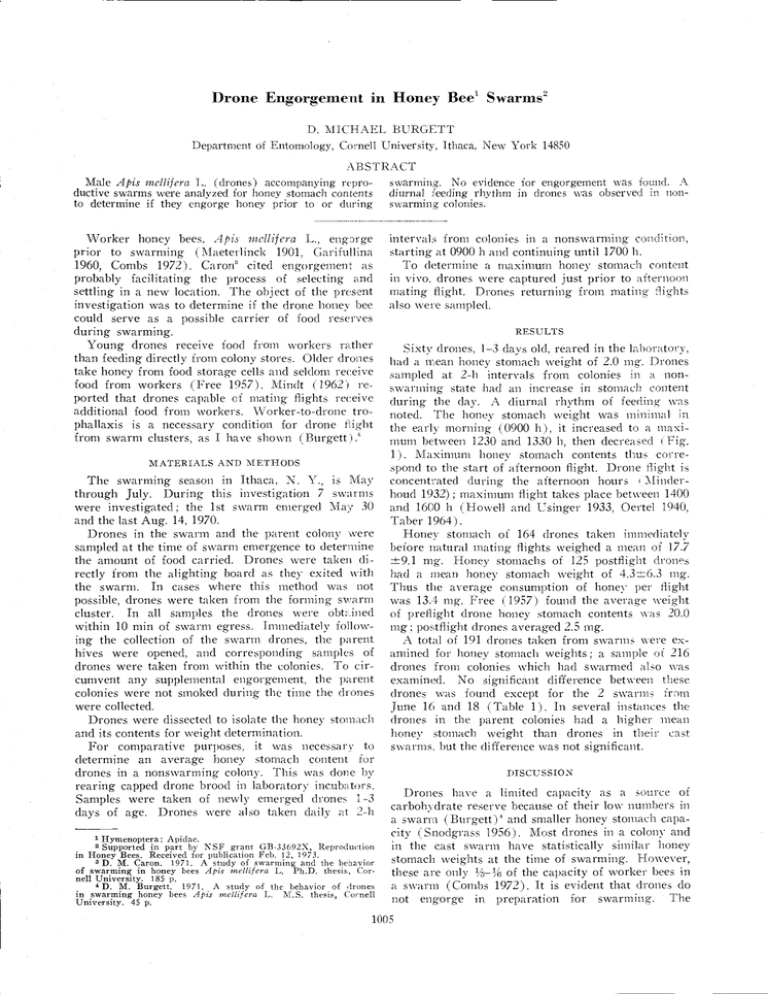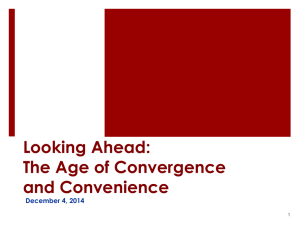Drone Engorgement in Honey Beet Swarms2 ABSTRACT
advertisement

Drone Engorgement in Honey Beet Swarms2
H. MICHAEL BURGETT
Department of Entomology, Cornell University, Ithaca, New York 14850
ABSTRACT
Male Apis mel/if era L. (drones) accompanying reproductive swarms were analyzed for honey stomach contents
swarming. No evidence or engorgentenl was tound. A
diurnal feeding rhythm in drones was observed in non-
t1\Torker honey bees, Apis mellifera L., engorge
prior to swarming (Maeterlinck 1901, Garifullina
1960, Combs 1972). Caront cited engorgement as
probably facilitating the process of selecting and
settling in a new location. The object of the present
intervals from colonies in a nonswarming cond:tion,
starting at 0900 h and continuing until 1700 li.
To determine a niaximuni honey stomach content
in vivo. drones were captured just prior to afternoon
mating flight. Drones returning from mating fliglsts
investigation was to determine if the drone honey bee
11150 Were sampled.
to determine if they engorge honey prior to or during
swarming colonies.
could serve as a possible carrier of food reserves
during swarming.
RESULTS
Young drones receive food from workers rather
than feeding directly from colony stores. Older drones
take honey from food storage cells and seldom receive
food from workers (Free 1957). Mindt (1962, reported that drones capable of mating flights receive
additional food from workers. Worker-to-drone trophallaxis is a necessary condition for drone flight
from swarm clusters, as I have shown (Burgett )
MATERIALS AND METHODS
The swarming season in Ithaca, N. Y., is May
through July. During this investigation 7 swarms
were investigated; the 1st swarm emerged Ma 30
and the last Aug. 14, 1970.
Drones in the swarm and the parent colony were
sampled at the time of swarm emergence to determine
Sixty drones, 1-3 days old, reared in the laboratory,
had a mean honey stomach weight of 2.0 nlg. Drones
sampled at 2-h intervals from colonies in a nonswarming state had an increase in stomach content
during the day, A diurnal rhythm of feeding was
noted, Tile honey stomach weight was minimal in
the early morning (0900 h it increased to a maxi,
mum between 1230 and 1330 h, then decreased Fig,
1). Maximum 11011ev stomach contents thus correspond to tile start of afternoon flight. Drone flight is
concentrated during the afternoon hours
Minderlioud 1932) ; maximum flight takes place between 1400
and 1600 h (Howell and Usinger 1933, Oertei 1940,
Taher 1964).
Honey stontach of 164 drones taken lnlnlecliatcly
before natural mating flights weighed a mean of 17.7
±9.1 mg. Honey stomachs of 125 postflight drones
the amount of food carried, Drones were taken directly from the alighting board as they exited with had a meal) honey stomach weight of 4.36.3 mg.
the swarm. In cases where this method was not Thus the average consumption of honey er flight
possible, drones were taken from tile forming swarm was 13.1 mg. Free (1957) found the average weight
cluster. In all samples the drones were ohtrinecl of preflight drone honey stomach contents s\as 20.0
within 10 mm of swarm egress
Tmmediately follow-
ing the collection of the swarm drones, the pareilt
hives were opened, and corresponding samples of
drones were taken from within the colonies. To circumvent any supplemental engorgement, the parent
colonies were not smoked during the time the drones
mg; postflight drones averaged 2.5 mg.
A total of 191 drones taken from swarms were ex-
amined for honey stomach weights; a sample of 216
drones from colonies which had swarmed also was
examined. No sigrnflcant difference between these
drones was found except for the 2 swarms from
June 16 and 18 (Table 1). In several instances tile
Drones were dissected to isolate the honey stomach drones in the parent colonies had a higher mean
and its contents for weight determination,
honey stomach weight than drones in their cast
were collected.
For comparative purposes, it was necessary to
determine an average honey stomach content for
drones in a nonswarming colony. This was done by
rearing capped drone brood in laboratory incubrtors.
Samples were taken of newly emerged drones 1-3
days of age. Drones were also taken daily at 2-h
'Hymenoptera: Apidae.
2 Supported in part by NSF grant GB-33692X, Reproduction
in Honey Bees. Received for publication Feb. 12, 1973.
D. M. Caron, 1971. A study of swarming and the behavior
of swarming in honey bees Apis inellif era L. Ph.D. thesis, Cor
nell University. 185 p.
D. M. Burgett. 1971. A study of the behavior of drones
in swarming honey bees Apis mellifera L, MS. thesis, Cornell
University. 45 p.
swarms. hut the difference was not significant.
DISCUSSION
Drones have a limited capacity as
a
source of
carboh3 drate reserve because of their low numbers in
a swarm (BurgetG5 and smaller honey stomach capa-
city (Snodgrass 1956). Most drones in a colony and
ill the cast swarm have statistically similar honey
stomach weights at tile time of swarming'. However,
these are only H- of the capacity of worker bees in
a swarm (Combs 1972). It is evident that thrones do
not engorge in preparation for swarming. The
1005
1006
{Vol. 66, no. 5
ANNALS OF THE ENTOMOLOGICAL SOCIETY OF AMERICA
Table 1Honey stomach Contents of drones from swarms and parent Colonies.
Mean ± SD weight (mg) of honey stomach and contents
Swarm number
Swarm
Parent hive
aP
1
2
3
4
5
6
7
5.43±4.78a
2.78±2.21
11.94±7.20a
6.16±5.20
5.71±4.27
5.73±5.13
7.73±7.85
6.32±6.44
5.79±5.77
8.53±5.94
8.55±5.78
7.53±5.75
4.34±4.46
4.93±5.09
0.05 > 0.01.
quantity of food reserves that drones contribute to
evidence presented here reiterates the hypothesis that
the communal stomach of a swarm is dependent upon
the time of day a swarm issues from the colony. The
the sole function of the drone honey bee is reproduction.
ACKNOWLEDGMENT
Honey stomach
weight mg.
I thank Dr. Roger A. Morse for advice and guidance during this investigation.
REFERENCES CITED
Reprinted from the
ANNALS OF THE ENTOMOLOGICAL SOCIETY OF AMERICA




